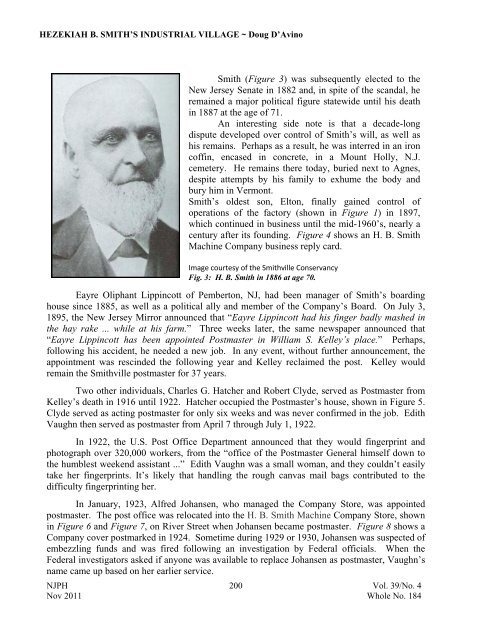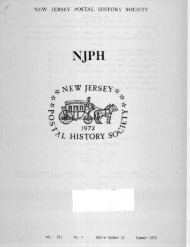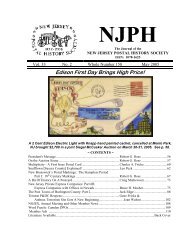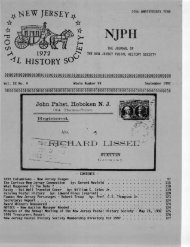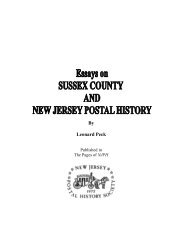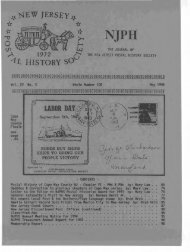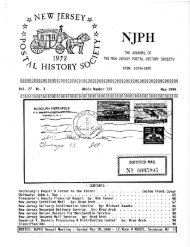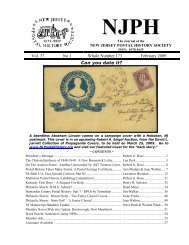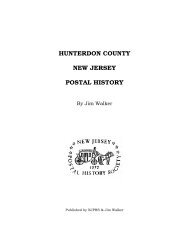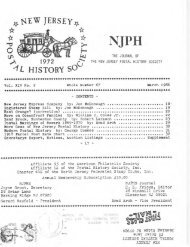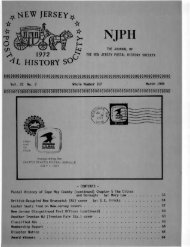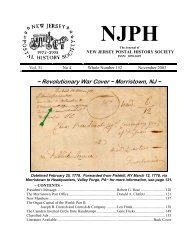NJPH - New Jersey Postal History Society
NJPH - New Jersey Postal History Society
NJPH - New Jersey Postal History Society
You also want an ePaper? Increase the reach of your titles
YUMPU automatically turns print PDFs into web optimized ePapers that Google loves.
HEZEKIAH B. SMITH’S INDUSTRIAL VILLAGE ~ Doug D’Avino<br />
Smith (Figure 3) was subsequently elected to the<br />
<strong>New</strong> <strong>Jersey</strong> Senate in 1882 and, in spite of the scandal, he<br />
remained a major political figure statewide until his death<br />
in 1887 at the age of 71.<br />
An interesting side note is that a decade-long<br />
dispute developed over control of Smith’s will, as well as<br />
his remains. Perhaps as a result, he was interred in an iron<br />
coffin, encased in concrete, in a Mount Holly, N.J.<br />
cemetery. He remains there today, buried next to Agnes,<br />
despite attempts by his family to exhume the body and<br />
bury him in Vermont.<br />
Smith’s oldest son, Elton, finally gained control of<br />
operations of the factory (shown in Figure 1) in 1897,<br />
which continued in business until the mid-1960’s, nearly a<br />
century after its founding. Figure 4 shows an H. B. Smith<br />
Machine Company business reply card.<br />
Image courtesy of the Smithville Conservancy<br />
Fig. 3: H. B. Smith in 1886 at age 70.<br />
Eayre Oliphant Lippincott of Pemberton, NJ, had been manager of Smith’s boarding<br />
house since 1885, as well as a political ally and member of the Company’s Board. On July 3,<br />
1895, the <strong>New</strong> <strong>Jersey</strong> Mirror announced that “Eayre Lippincott had his finger badly mashed in<br />
the hay rake ... while at his farm.” Three weeks later, the same newspaper announced that<br />
“Eayre Lippincott has been appointed Postmaster in William S. Kelley’s place.” Perhaps,<br />
following his accident, he needed a new job. In any event, without further announcement, the<br />
appointment was rescinded the following year and Kelley reclaimed the post. Kelley would<br />
remain the Smithville postmaster for 37 years.<br />
Two other individuals, Charles G. Hatcher and Robert Clyde, served as Postmaster from<br />
Kelley’s death in 1916 until 1922. Hatcher occupied the Postmaster’s house, shown in Figure 5.<br />
Clyde served as acting postmaster for only six weeks and was never confirmed in the job. Edith<br />
Vaughn then served as postmaster from April 7 through July 1, 1922.<br />
In 1922, the U.S. Post Office Department announced that they would fingerprint and<br />
photograph over 320,000 workers, from the “office of the Postmaster General himself down to<br />
the humblest weekend assistant ...” Edith Vaughn was a small woman, and they couldn’t easily<br />
take her fingerprints. It’s likely that handling the rough canvas mail bags contributed to the<br />
difficulty fingerprinting her.<br />
In January, 1923, Alfred Johansen, who managed the Company Store, was appointed<br />
postmaster. The post office was relocated into the H. B. Smith Machine Company Store, shown<br />
in Figure 6 and Figure 7, on River Street when Johansen became postmaster. Figure 8 shows a<br />
Company cover postmarked in 1924. Sometime during 1929 or 1930, Johansen was suspected of<br />
embezzling funds and was fired following an investigation by Federal officials. When the<br />
Federal investigators asked if anyone was available to replace Johansen as postmaster, Vaughn’s<br />
name came up based on her earlier service.<br />
<strong>NJPH</strong> 200<br />
Vol. 39/No. 4<br />
Nov 2011 Whole No. 184


